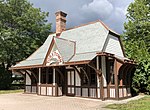Franklin D. Roosevelt State Park
Civilian Conservation Corps in New York (state)Hudson Valley, New York geography stubsMonuments and memorials to Franklin D. Roosevelt in the United StatesParks in Westchester County, New YorkState parks of New York (state) ... and 1 more
Yorktown, New York
Franklin D. Roosevelt State Park is a 960-acre (3.9 km2) state park in Westchester County, New York. Formerly known as Mohansic Park and Mohansic State Park, it is situated in Yorktown, approximately 40 miles (64 km) from New York City. The park was created in 1922 on the former site of the Mohansic State Hospital. The park includes two water bodies, Mohansic Lake and Crom Pond.
Excerpt from the Wikipedia article Franklin D. Roosevelt State Park (License: CC BY-SA 3.0, Authors).Franklin D. Roosevelt State Park
FDR State Park Road,
Geographical coordinates (GPS) Address Nearby Places Show on map
Geographical coordinates (GPS)
| Latitude | Longitude |
|---|---|
| N 41.283 ° | E -73.809 ° |
Address
FDR State Park Road
FDR State Park Road
10598
New York, United States
Open on Google Maps






